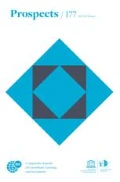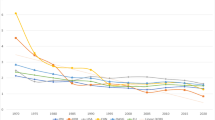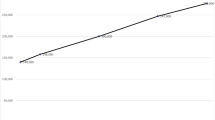Abstract
Many countries are now creating world-class universities (WCUs) as essential parts of their higher education reform agendas, and as national goals. It is legitimate to ask whether every county that aspires to build a WCU can do so—especially developing countries. To answer this question, this paper provides a three-step framework. The first step in building a WCU is to understand its characteristics. The second is for the country to systematically assess whether it has the capacity to create a WCU by rationally appreciating the challenges it would face in creating one. Third, it must understand, given the challenges discovered in the second step, what to do to create a WCU. Considering this framework, only a few developing countries have the potential to foster a WCU. Thus it is difficult for many universities in developing countries to enter an existing market already occupied by well-developed education systems and universities.

Similar content being viewed by others
References
Ainslie, C. (2011). Structures and approaches for maximizing outcomes. Ithaca, NY: Cornell University Workforce Planning Initiative.
Altbach, P. G. (2004). The costs and benefits of world-class universities. Academe, 90(1), 20–23.
Altbach, P. G. (2007). Empires of knowledge and development. In P. G. Altbach & J. Balan (Eds.), World class worldwide: Transforming research universities in Asia and Latin America (pp. 1–28). Baltimore: Johns Hopkins University Press.
Altbach, P. G. (2009). Peripheries and centers: Research universities in developing countries. In J. Sadlak & N. C. Liu (Eds.), The world-class university as part of a new higher education paradigm: From institutional qualities to systemic excellence (pp. 69–96). Bucharest and Cluj-Napoca: UNESCO-CEPES and Cluj University Press.
Altbach, P. G. (2011). The academic profession: The realities of developing countries. In P. G. Altbach (Ed.), Leadership for world-class universities: Challenges for developing countries (pp. 205–223). New York: Routledge.
Altbach, P. G., & Balan, J. (Eds.) (2007). World class worldwide: Transforming research universities in Asia and Latin America. Baltimore: Johns Hopkins University Press.
Balan, J. (2007). Higher education policy and the research university: In Asia and Latin America. In P. G. Altbach & J. Balan (Eds.), World class worldwide: Transforming research universities in Asia and Latin America (pp. 286–308). Baltimore: Johns Hopkins University Press.
Bellon, B. (2009). The restructuring of the French national system of research vis-à-vis the world-class universities. In J. Sadlak & N. C. Liu (Eds.), The world-class university as part of a new higher education paradigm: From institutional qualities to systemic excellence (pp. 232–254). Bucharest and Cluj-Napoca: UNESCO-CEPES and Cluj University Press.
Birnbaum, R. (2007, Spring). No world-class university left behind. International Higher Education, 47, 7–9.
Downie, A. (2011, October 16). In Chile, students’ anger at tuition debt fuels protests and a national debate. The Chronicle of Higher Education. https://chronicle.com/article/In-Chile-Students-Anger-at/129424/.
ETH Zurich [Swiss Federal Institute of Technology Zurich] (2011). ETH Zurich annual report 2010. Zurich: ETH Zurich, Corporate Communications.
HEFCE [Higher Education Funding Council for England] (2010). Guide to funding: How HEFCE allocates its funds. Bristol: HEFCE.
Heyneman, S. P., & Lee, J. (2012). World class universities: The sector requirements. In J. Shin & B. Kehm (Eds.), Institutionalization of a world class university in global competition (pp. 45–58). New York: Springer.
Hsiou-Hsia, T. (2007). The features of a world-class university: Lessons from international ranking. In J. Sadlak & N. C. Liu (Eds.), The world-class university and ranking: Aiming beyond status (pp. 31–38). Bucharest and Cluj-Napoca: UNESCO-CEPES and Cluj University Press.
Indiresan, P. V. (2007). Prospects for world-class research universities in India. In P. G. Altbach & J. Balan (Eds.), World class worldwide: Transforming research universities in Asia and Latin America (pp. 95–121). Baltimore: Johns Hopkins University Press.
Jayaram, N. (2003). The fall of the guru: The decline of the academic profession in India. In P. G. Altbach (Ed.), The decline of the guru: The academic profession in developing and middle-income countries (pp. 199–230). New York: Palgrave.
Jayaram, N. (2007). Beyond retailing knowledge: Prospects of research-oriented universities in India. In P. G. Altbach & J. Balan (Eds.), World class worldwide: Transforming research universities in Asia and Latin America (pp. 70–94). Baltimore: Johns Hopkins University Press.
Johnstone, B. (2011). The challenge of university leadership in the developing world. In P. G. Altbach (Ed.), Leadership for world-class universities: Challenges for developing countries (pp. 176–186). New York: Routledge.
Kim, S. (2007, September). One size does not fit all: Guidelines for promoting community engagement and higher education’s contribution to regional development. Paper presented at the regional seminar, Competition, Cooperation and Change in the Academic Profession: Shaping Higher Education’s Contribution to Knowledge and Research, Hangzhou, China.
Liu, N. C., Wang, Q., & Cheng, Y. (Eds.) (2011). Paths to a world-class university: Lessons from practices and experiences. Rotterdam: Sense Publishers.
Lowen, R. S. (1997). Creating the cold war university: The transformation of Stanford. Berkeley: University of California Press.
LSE [London School of Economics and Political Science] (2011). Statistics on students. http://www2.lse.ac.uk/intranet/LSEServices/planningAndStatistics/informationManagementAndStatistics/pdf/Table%20I.pdf.
Ma, W. (2007). The flagship university and China’s economic reform. In P. G. Altbach & J. Balan (Eds.), World class worldwide: Transforming research universities in Asia and Latin America (pp. 31–53). Baltimore: Johns Hopkins University Press.
Maldonado-Maldonado, A. (2009). Latin American higher education: Hope in the struggle? In P. G. Altbach (Ed.), Leadership for world-class universities: Challenges for developing countries (pp. 73–93). New York: Routledge.
Maret, P. D. (2007). Universities in the world: What for? In J. Sadlak & N. C. Liu (Eds.), The world-class university and ranking: Aiming beyond status (pp. 31–38). Bucharest and Cluj-Napoca: UNESCO-CEPES and Cluj University Press.
Marlin, C. (2011). World-class research performance through research focus and the strategic use of research resources. In N. C. Liu, Q. Wang, & Y. Cheng (Eds.), Paths to a world-class university: Lessons from practices and experiences (pp. 195–203). Rotterdam: Sense Publishers.
MIT [Massachusetts Institute of Technology] (2003). MIT’s industrial partnerships. Report of the Ad Hoc Committee on Industrial Partnership Review. Cambridge, MA: MIT.
MIT [Massachusetts Institute of Technology] (2011). MIT facts 2011. Cambridge, MA: MIT.
Mukhammadiev, A. (2010). Central Asia. In UNESCO (Ed.), UNESCO science report 2010: The current status of science around the world (pp. 235–249). Paris: UNESCO.
NCES [National Center for Education Statistics] (2011). Digest of education statistics 2010. Washington, DC: NCES, Institute of Education Sciences.
Noukakis, D., Ricci, J.-F., & Detterli, M. (2011). Riding the globalization wave: EPFL’s strategy and achievements. In N. C. Liu, Q. Wang, & Y. Cheng (Eds.), Paths to a world-class university: Lessons from practices and experiences (pp. 177–193). Rotterdam: Sense Publishers.
QS [Quacquarelli Symonds Limited] (2004). QS world university rankings. http://www.topuniversities.com/university-rankings/world-university-rankings/home.
QS [Quacquarelli Symonds Limited] (2012). QS world university rankings 2012 report. http://www.itesm.la/archivos/QS_World_University_Rankings.pdf.
Palfreyman, D., & Tapper, T. (2009). What is an elite or leading global university? In D. Palfreyman & T. Tapper (Eds.), Structuring mass higher education: The role of elite institutions (pp. 203–218). New York: Routledge.
Ramakrishna, S., & Krishna, V. V. (2011). Emergence of Asian universities as centres of new knowledge and generation and a base for national competitiveness: A case study of the National University of Singapore. In N. C. Liu, Q. Wang, & Y. Cheng (Eds.), Paths to a world-class university: Lessons from practices and experiences (pp. 205–236). Rotterdam: Sense Publishers.
Ramkissoon, H., & Kahwa, I. A. (2010). The CARICOM countries. In UNESCO (Ed.), UNESCO science report 2010: The current status of science around the world (pp. 133–145). Paris: UNESCO.
Ratchford, J. T., & Blanpied, W. A. (2010). United States of America. In UNESCO (Ed.), UNESCO science report 2010: The current status of science around the world (pp. 29–59). Paris: UNESCO.
Ruiz-Rodgers, N. (2011). The role of the research university in the third world: A case study of the National University of Colombia. In N. C. Liu, Q. Wang, & Y. Cheng (Eds.), Paths to a world-class university: Lessons from practices and experiences (pp. 107–124). Rotterdam: Sense Publishers.
Sadlak, J., & Liu, N. C. (2007). Introduction to the topic: Expectations and realities of world-class university status and ranking practices. In J. Sadlak & N. C. Liu (Eds.), The world-class university and ranking: Aiming beyond status (pp. 17–23). Bucharest and Cluj-Napoca: UNESCO-CEPES and Cluj University Press.
Sadlak, J., & Liu, N. C. (Eds.) (2009). The world-class universities as part of a new higher education paradigm: From institutional qualities to systemic excellence. Bucharest and Cluj-Napoca: UNESCO-CEPES and Cluj University Press.
Salmi, J. (2009). The challenge of establishing world-class universities. Washington, DC: The World Bank.
Salmi, J. (2010, August 22). Nine common errors when building a new world-class university. Inside Higher Ed. http://www.insidehighered.com/blogs/the_world_view/nine_common_errors_when_building_a_new_world_class_university.
Salmi, J., & Liu, N. C. (2011). Paths to a world-class university. In N. C. Liu, Q. Wang, & Y. Cheng (Eds.), Paths to a world-class university: Lessons from practices and experiences (pp. ix–xviii). Rotterdam: Sense Publishers.
Schwartzman, S. (2007). Brazil’s leading university: Original ideals and contemporary goals. In P. G. Altbach & J. Balan (Eds.), World class worldwide: Transforming research universities in Asia and Latin America (pp. 143–172). Baltimore: Johns Hopkins University Press.
Shils, E. (1972). The intellectuals and the powers and other essays. Chicago: University of Chicago Press.
TFHES [Task Force on Higher Education and Society] (2000). Higher education in developing countries: Peril and promise. Washington, DC: World Bank.
Taylor, P., & Braddock, R. (2007). International university ranking systems and the idea of university excellence. Journal of Higher Education Policy and Management, 29(3), 245–260.
Teferra, D., & Altbach, P. G. (2002). Trends and perspectives in African higher education. In D. Teferra & P. G. Altbach (Eds.), African higher education: An international reference handbook (pp. 3–14). Bloomington: Indiana University Press.
Tremblay, M. (2000). What are the characteristics of world class universities? http://www.tremblay-consulting.biz/files/Innovation/world%20class%20innovation.pdf.
UNESCO (2010). UNESCO science report 2010: The current status of science around the world. Paris: UNESCO.
UPM [Universiti Putra Malaysia] (2011). UPM facts & figures. http://www.upm.edu.my/about_us/Facts&Figures?LANG=en.
Van Raan, A. F. J. (2009, February). Ranking and classification of universities based on advanced bibliometric mapping. Paper presented at the Third International Symposium on University Rankings, Leiden, the Netherlands.
Wang, Y. (2001). Building the world-class university in a developing country: Universals, uniqueness, and cooperation. Asia Pacific Education Review, 2(2), 3–9.
Watson, D. (2007). Managing civic and community engagement. New York: McGraw-Hill.
Wooldridge, A. (2005, September 8). The brains business: A survey of higher education. The Economist. http://www.economist.com/node/4339960.
World Bank (1995). Priorities and strategies for education. Washington, DC: World Bank.
Yonezawa, A. (2011). The “Global 30” and the consequences of selecting world-class universities in Japan. In N. C. Liu, Q. Wang, & Y. Cheng (Eds.), Paths to a world-class university: Lessons from practices and experiences (pp. 67–81). Rotterdam: Sense Publishers.
Ze Amvela, E. (2011). The role of elite universities in Africa: A case study of the University of Yaounde I in Cameroon. In N. C. Liu, Q. Wang, & Y. Cheng (Eds.), Paths to a world-class university: Lessons from practices and experiences (pp. 159–175). Rotterdam: Sense Publishers.
Author information
Authors and Affiliations
Corresponding author
About this article
Cite this article
Lee, J. Creating world-class universities: Implications for developing countries. Prospects 43, 233–249 (2013). https://doi.org/10.1007/s11125-013-9266-x
Published:
Issue Date:
DOI: https://doi.org/10.1007/s11125-013-9266-x




